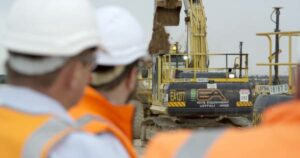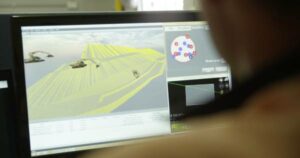Australia’s largest-yet application of the latest site management telematics systems, combined with Topcon GPS-based precision machine guidance, has been setting new safety and productivity standards in a major upgrade to a key water supply reservoir for Melbourne’s western and northwestern suburbs.
Thiess is carrying out an upgrade of the dam wall for Melbourne Water’s Greenvale Reservoir to ensure a secure water supply for the city’s western suburbs.
It is using a fleet of earthmoving equipment – including around 15 excavators fitted with Topcon’s X63 indicate system – supplied by national plant hirer, EA Hire Equipment, and all integrated with Topcon’s SiteLink 3D system and Aptella’ Tokara Service system.
The Greenvale Reservoir, with a storage capacity of 27,500 million litres, was completed in 1971 and is Melbourne’s most urbanised large dam, is located just 20 km from the city’s CBD.
The work involves strengthening the reservoir by installing new filter zones and earthfill on the downstream embankment, to ensure a continued secure water supply and to maintain public safety.
This involves cutting back around two-thirds of the 2.8 km long dam wall, installing these fine and coarse filter zones, then reinstating the embankment, said Garry Plautz, Thiess’s superintendent on the project.

“The total project entails removing 300,000 cubic metres of material to stockpiles, then importing 160,000 tonnes of sand to build the filters that are placed up the excavated batters, then compacting all the earth fill back in layers,” he said.
With the dam walls up to 17.5 m high, and with 3:1 batters, plus a tight construction schedule, Plautz said that for safety and productivity reasons, Thiess wanted to eliminate people on the ground around the multiple pieces of earthmoving equipment – mainly excavators and scrapers – working on the embankment.
“We didn’t want surveyors or other workers walking in and around the equipment while it was working – whether they were checking levels and as-builts, or delivering construction plans to the equipment,” he said.
“Basically we wanted to eliminate people on the ground, which is why we approached Aptella about their Tokara system. It allows us to remotely transfer data between the survey office and the machines on the ground, taking away the interface between plant and people.
“It’s really about safety and production; if people are on the ground near machinery, the machine has got to stop. For example, every time the surveyor goes into an excavator’s slew zone, or within 15 metres, the machine has to stop,” said Plautz.
In addition to conventional buckets, EA Hire’s excavators on this project were fitted with 4.9 m stick-mounted blades for shaping the filters, and 1.5 m by 2.5 m plate compactors to compact and stabilise the sand.
Digital models for the initial embankment removal, filter placement – there are up to 12 different filter designs – and embankment reinstatement are built up by Thiess’s team of on-site surveyors, then delivered remotely to the excavators using Tokara Service.
These digital models are then used with Topcon’s X63 indicate system for excavation, filter and material placement.
“Once the excavators have finished cutting to the design levels, whether it be on a batter or on the floor of the dam, the operators are able to save that data and send it to the survey office, again using Tokara,” said Plautz.
“That means we get real-time survey data back at the office and we’re able then to put that information into a report for the project to be signed off by the client.
“That data is accepted as as-built by the client, as it’s no different to what we’d get from a conventional survey,” he said.
Likewise placement of the filters and reinstatement of the embankment is all done using the X63 system from the digital models supplied.
“We don’t actually have to survey those; that’s all done and visually inspected in the field.
“And once the filters are shaped up by the excavators then scrapers come in and place the 1A embankment materials, and then up goes the dam wall. And it’s just a matter of repeating the process,” said Plautz.

The fine filters are constructed of specially selected imported sand, brought in from a quarry around 150 km away from the site, and moistened with water to allow the sand to be compacted.
Filter construction techniques vary, depending on their location and design; some are loaded by the excavators out the back of a tipper, others are dumped from side-tipping semis then graded and shaped into place using the blade-mounted excavators before being compacted.
According to EA Hire’s managing director Laurence Eales, the combination of the Topcon’s X63 excavator system, Position Partner’s Tokara Service and SiteLink 3D system enabled his company to deliver a solution for the Greenvale project that was essentially labour-free out on site.
“The whole way this project has been set up has generated huge savings in time and increased productivity,” he said.
“Having Tokara on all our excavators has meant Aptella was able to develop a database so that the excavators can all deliver as-built data and images of the work they’ve done – and that’s meant huge savings all round.
“This is one of the first projects in Australia where we’ve actually utilised all these systems on the machines to eliminate the need for surveyors out in the field,” said Eales.
“And with SiteLink 3D, our client Thiess has the option to see on a single computer screen all the machines on site, what everyone’s working on, and if there’s any areas where they need more resources.
“It means they can check progress of each machine, and download files and information remotely.
“When Thiess came to us about this project, they had a pretty firm idea of what they wanted to achieve,” he said.
“We put in a lot of work with Aptella to ensure we could bring Thiess the solutions they were after – and it was good to see that we have been able to deliver them.
“We’ve now got all these machines out there that are remotely feeding all this information back to Thiess’s head office.
“It’s all been a great success,” said Eales. “The way we’ve done this project has saved our client a lot of money and a lot of time.
“This project really is a bit of a white paper on what can be done with this technology; I think a lot of other projects out there will be very interested in what we’ve achieved – and there will be major advantages for others applying the lessons we’ve learnt.”
Josh Allan, Aptella’ machine systems sales manager for Victoria and Tasmania said that the Greenvale Reservoir project had been a three-way partnership between Thiess, EA Hire Equipment and Aptella to come up with site management and machine control solutions that met the project’s requirements.
“We all worked very closely together to come up with site management telematics solutions that would allow the Thiess surveyors to instantly transfer updated DTMs to the machines on the ground,” he said.
“Our aim was to optimise dataflow, and eliminate the need for surveyors to be on the ground physically delivering the revised designs to machine operators.
“In a major project such as Greenvale, there are always design changes required while the project proceeds, with the engineers feeding back to the surveyors their changing requirements – which then need to be transferred to the machines on the ground.
“Tokara Service really simplifies and streamlines this dataflow process, ensuring constant communication as required between the surveyors in the design office and the onsite machines,” said Allan.
“We also geared up significantly through our Project Service Team in Victoria, to ensure we had the resources in place to meet the demands of this project.
“This gives us the ability to provide the service, support and expertise to manage contractors’ requirements in complex major projects, and ensure maximum uptime for the site management systems and the machines carrying out the work,” he said.
Aptella offers a network of Project Service Teams around Australia, providing the specialised services to assist in delivering on a range of major projects.
Allan said that in the case of Greenvale, Aptella wanted to ensure it had the right tech support staff available at the right times.
“With the implementation of Tokara Service and Sitelink 3D being new for many of the people on this project we had to make sure the right training was delivered,” he said.
“In addition, we had a rapid ramp up of machines, combined with operators having varying levels of experience with machine-guided systems.
“For this reason, we created and delivered a custom ‘verification of competency’ (VOC) program.
“This involved working with Thiess and EA Hire to ensure the whole site was running with a common understanding of the systems and procedures that were being implemented.
“We really feel that this whole process has helped significantly with increasing productivity on the project,” Allan said.
Project superintendent Garry Plautz said that as a result of this process, the implementation of the site management telematics elements of the Greenvale project went very smoothly.
“It was a very fast ramp up. It took about four hours to set each machine up to be able to remotely receive and send the files from and to our surveyors, then they went to work straight away,” he said.
“In terms of eliminating people on site, it worked really well; you don’t see people on the ground at all.
“The impact of having surveyors out there doing pickups all the time would have been massive; it would have been hours and hours of lost production,” said Plautz.
“It will definitely allow us to finish this job a lot sooner than with conventional methods.
“And the other thing is, you couldn’t actually do this project without GPS; we couldn’t have pegged any of it, so GPS was the only way it was going to get done,” he said.
“We did a lot of work with Aptella and EA Hire to get the systems in place we needed to do this job.
“And the client had never used GPS on a site like this before, so they were very interested to see how it would work.
“We believe this is the first time this technology has been used on such a large scale – and it’s all worked very well for us,” Plautz said.

We source, deploy and support intelligent positioning solutions to enhance our customers’ productivity.
Aptella Pty Ltd
ABN 56 130 367 065
2024 Aptella Pty Ltd | ABN 56 130 367 065 | Terms and Conditions | Privacy Policy